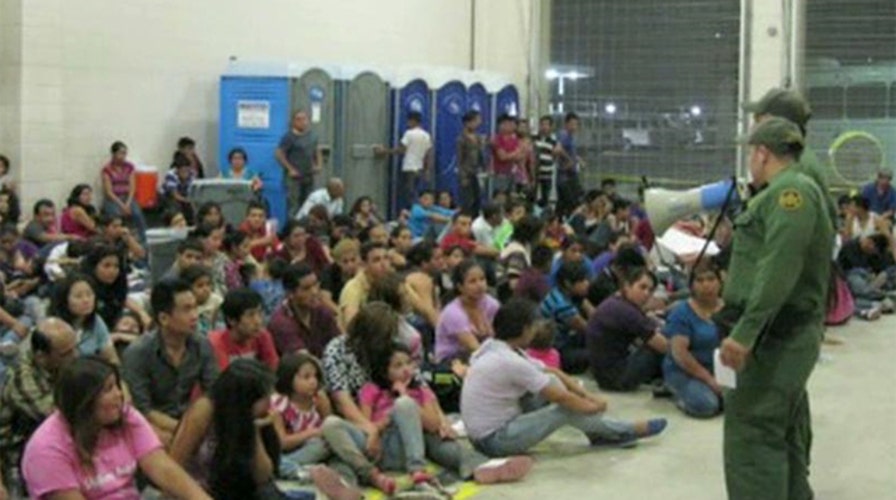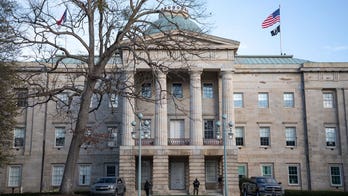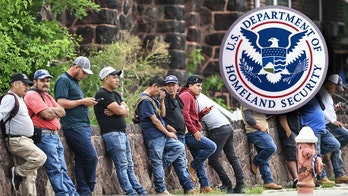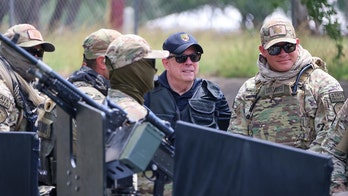Illegal immigration impact goes beyond border states
Rep. Jim Bridenstine on the widespread effect of the influx at the border and why he called a trip to an immigration detention facility to the the former Soviet Union
The surge of tens of thousands of illegal immigrant children from Central America into Texas has revived calls for a border security measure long mocked by Democrats but touted by Republicans as a commonsense solution: A big, long fence.
Those calls became even louder after President Obama submitted a $3.7 billion emergency funding request to address the immigration crisis that did not include much in the way of border security. The package was focused mostly on covering detention and transportation costs, deportations, health care and immigration judges and lawyers.
"If we want to solve this problem, we need to secure the southern border," Rep. Jim Bridenstine, R-Okla., told Fox News.
Bridenstine is pushing for the enforcement of The Secure Fence Act of 2006. The law, signed by then-President George W. Bush, authorized hundreds of miles of fence construction along the southern border, in addition to more checkpoints, cameras, vehicle barriers and lighting to catch people.
His office cites findings that the U.S. only has "operational control" over 44 percent of the southern border, and notes the law requires 100 percent control. To achieve that, he wants the National Guard deployed to augment the Border Patrol and construction completed on 700 miles of double-layer fence.
The federal government built one section of the fence, near San Diego, starting back in the 1990s, which is double- and, in spots, triple-layered. Advocates of a massive, reinforced fence point to the San Diego stretch as a model.
Since the 2006 law was signed, the Department of Homeland Security has installed hundreds of miles of additional fencing -- as of January 2013, the department reported installing 299 miles of vehicle fencing and 352 miles of pedestrian fencing. Most of that, however, is not double-layered.
In a July 5 op-ed in The San Diego Union-Tribune, Rep. Duncan Hunter, R-Calif., said less than 40 miles of fencing along the border is double-layered, and while single-layer pedestrian fencing and vehicle barriers elsewhere "might be better than nothing," more should be done.
"Fencing and infrastructure alone are by no means enough to stop illegal crossings, but the presence of physical impediments at the border, when supported by manpower and technology, create barriers that make entry increasingly more difficult and sometimes impossible," he wrote.
"Either the mandates of the Secure Fence Act should be reinstated, which I have proposed, or the Obama administration should utilize existing authority to finish the job that the Bush Administration halfheartedly started."
Critics of the fence plan question its effectiveness and say it's simply too costly. The Washington Office on Latin America says fully carrying out the 2006 law would cost over $4.1 billion -- which is more than Obama's entire emergency request.
The issue has proved fodder for Democrats who have mocked the idea as over the top.
Obama, defending his own border security measures, said in 2011 that Republicans were trying to "move the goalposts" on what level of border security they want.
"They said we needed to triple the Border Patrol. Now they're gonna say we need to quadruple the Border Patrol, or they'll want a higher fence -- maybe they'll need a moat. Maybe they want alligators in the moat."
GOP presidential candidate Herman Cain, seemingly jokingly, supported that idea a few weeks later, calling in addition for an electrified barbed wire fence.
Fox News analyst and syndicated columnist Charles Krauthammer countered the fence plan criticism.
"If fences don't work, why is there one around the White House?" he said on Fox News last week. "If they don't work, why is it that the Israeli fence which separates Israel from the West Bank has cut down terror attacks within Israel by 99 percent. Fences work."
But even if the fence is a political long shot, the issue of border security is getting more attention after it was conspicuously left out of the $3.7 billion request.
"Where's the beef? Where is the money for border security? This does nothing to secure the border," National Border Patrol Council Vice President Shawn Moran told Fox News.
White House Press Secretary Josh Earnest acknowledged that the request "principally focuses on these immigration court resources -- judges, lawyers, prosecutors, asylum officials -- who can make sure that these cases are processed more efficiently. "
He said the administration wants to make sure they have the resources to process cases more quickly and, where possible, return people to their home countries. As for border security, he said an immigration reform bill that would address that is being "blocked by Republicans in the House."
"So those who claim that they are against comprehensive immigration reform, but yet are committed to criticizing the president for his lack of effort to secure the border, are open to have their motives questioned," Earnest said.
The president's request does include $39 million for increased air surveillance along the border, as well as money for a Border Enforcement Security Task Force program and for Border Patrol overtime costs. But the largest chunk -- $1.8 billion -- is for the Department of Health and Human Services, which is tasked with caring for the unaccompanied children under federal law.
Senate Democratic leaders are pushing for Congress to approve the measure, but the House would have to go first and it's unclear for now whether House Speaker John Boehner has the votes.





